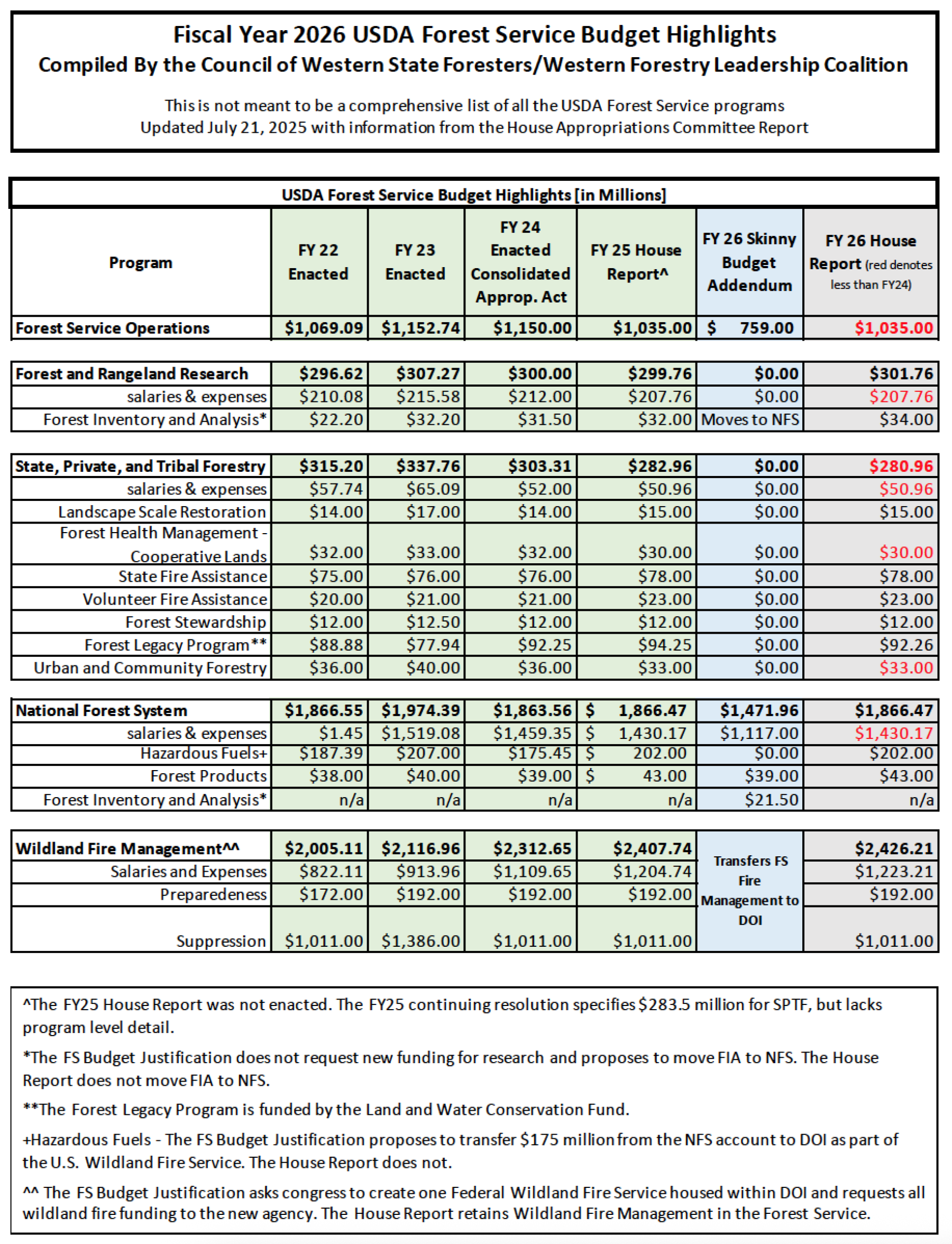(To download a PDF of the Policy Update, please visit our publication library.)
Read the latest policy update from Neil Simpson, CWSF/WFLC Director of Policy. This month’s policy update covers:
- Fiscal Year (FY) 2026 Appropriations Deep Dive
- $80 million in funding for Wood Innovations Grants
- EPA Proposes Regulatory Changes for the Renewable Fuels Standard Program
- SAWMILL Act Introduced
- Wildfire Resilient Communities Act
- Direct Hire to Fight Fires Act Passes Committee
- Trump Establishes the Make America Beautiful Again Commission
FY 2026 Appropriations Deep Dive
Senate Appropriations Subcommittee on Interior, Environment, and Related Agencies held a hearing on the USDA Forest Service (Forest Service) budget on June 11, and the Energy and Natural Resources Committee held a hearing on July 10.
The House Appropriations Subcommittee on Interior, Environment, and Related Agencies voted to advance the FY 26 Interior, Environment, and Related Agencies Appropriation Bill for consideration by the full committee, which voted to advance the bill to the House floor during a markup on July 22.
The proposed budget provides $8.54 billion for the Forest Service, $16.8 million below the FY 2025 enacted level. The table below compares the committee’s marks to the President’s proposed budget and past years' appropriations levels.

The bill would not consolidate federal Wildland Fire Management into one agency as the President’s budget proposes. On page 13 of the accompanying House Report, the Committee notes concerns that restructuring the Forest Service and creating a consolidated Fire Service within the U.S. Department of the Interior (DOI) could influence the "fundamental purpose of the Forest Service” and “impact the agencies’ ability to achieve critical performance benchmarks” such as timber harvest and hazardous fuels reduction goals.
“The Committee directs the U.S Government Accountability Office to conduct a study regarding the creation of a consolidated Fire Service within DOI that assesses the impacts on reaching proposed timber targets, continued cohesion between wildland fire management and the hazardous fuels reduction program, continued use of the available red card-certified workforce, and how this new consolidated Service differs from the role the National Interagency Fire Center (NIFC) already plays to coordinate fire response. Additionally, the study should evaluate the extent to which states, localities, and Tribes were consulted regarding plans to create this new Fire Service and consider what impact this transfer may have on these critical stakeholders.”
The Report also addresses reprogramming of funds. It reminds agencies (pg. 4) they must obtain approval from the Committee before moving more than 10 percent or one million dollars of funds between budget line items and that these rules also apply to any “reorganizations, workforce restructure, reshaping, transfer of functions, or bureau-wide downsizing and include closures, consolidations, and relocations of offices, facilities, and laboratories.”
The Report contains numerous statements and directives from the Committee, including:
- Recognizes the DOI and Forest Service’s intention to move beyond acres treated and requires a report to the Committee regarding how the agencies will report on outcomes beyond acres treated and what commercially available support tools they will use (pg. 6).
- Concern that litigation undermines the goals of the Forest Service, Environmental Protection Agency (EPA), and DOI, and settlements limit the agencies' abilities to accomplish objectives (pg. 7).
- Direct the Forest Service and National Park Service to continue expediting fuels reduction projects in giant sequoia groves (pg. 8).
- Directs the Government Accountability Office to examine existing wildland fire programs, rules, and authorities at DOI and the Forest Service that inhibit cross-boundary work with non-federal partners (pg. 15)
- Directs the Secretary of the Interior to issue the final rule titled ‘‘Endangered and Threatened Wildlife and Plants; Regulations for Interagency Cooperation’’ reversing the Ninth Circuit Court’s Cottonwood Decision and clarifying that reinitiation of consultation would not be required for land management plans when there is new information related to Endangered species (pg. 55)
- Encourages the Forest Service to support urban agroforestry and increase canopy cover in vulnerable areas most severely impacted by urban heat (pg. 75)
- Directs $30 million to the Wood Innovations and Community Wood Grant programs, an increase of $10 million from FY 24 enacted levels (pg. 76).
- Supports the President’s Executive Order titled ‘‘Immediate Expansion of Timber Production’’ and directs the Forest Service to set annual timber targets at or near each forest’s sustained yield (pg. 77).
- Encourages the Forest Service to continue engagement with states and Tribes on Good Neighbor Authority (GNA) (pg. 78)
- Encourages the Forest Service to work with states and partners to support activities that increase regional seedling supplies, including establishment and expansion of federal nurseries and seed extractories (pg. 78).
The bill authorizes up $20 million of Hazardous Fuels Management funds to be used on non-federal lands, and contains several administrative provisions that remain unchanged from previous years, including:
- Funds can be transferred between Forest Service accounts, provided no funds increase or decrease by greater than 10 percent.
- If all funds within the Wildland Fire Management account will be obligated within 30 days, other Forest Service appropriations may be transferred to the Wildland Fire Management account.
- Up to $50 million of Forest Service Funds may be transferred to DOI for wildland fire management, hazardous fuels management, and state fire assistance to facilitate and expedite wildland fire management programs and projects.
- Appropriations committees may approve the transfer of unobligated balances from one program area to or within the National Forest System account or reprogram funds for hazardous fuels management and burned area recovery.
- The Forest Service may use appropriated funds to support forest and grassland collaborative groups to accomplish activities benefitting federal lands and adjacent non-federal land.
The Senate Appropriations Committee will hold a markup of its Interior and Environment Appropriations Bill on July 24, 2025. You can watch the hearing on the committee’s website.
USDA Announces $80 Million in Funding for Wood Innovations Grants
USDA Secretary, Brooke L. Rollins, announced the Forest Service is awarding $80 million in Wood Innovation Grants to spur wood products manufacturing, expand active forest management, and accelerate energy innovation.
In the July 17, 2025, press release, Secretary Rollins states, “The United States is blessed with a bounty of natural resources that we must properly manage to sustain our future economy and boost rural communities. Proper forest use and management lowers our reliance on foreign products and is inherently aligned with President Trump’s America First agenda.”
EPA Proposes Regulatory Changes for the Renewable Fuels Standard Program
The EPA is proposing several regulatory changes to the Renewable Fuels Standard Program, which supports utilizing forest residues and other biomass to produce renewable fuels. The EPA is requesting comments on potential changes that could improve the program, including:
- Program enhancements to increase the use of qualifying woody-biomass to reduce wildfire risk.
- How to maximize the eligibility of biomass residues generated at sawmills and other forest products manufacturing facilities.
Comments are due by August 8, 2025, and can be submitted on Regulations.gov. More information is available in the Federal Register Notice.
Merkley and Sheehy Introduce the SAWMILL Act
Senators Merkley (D-OR) and Sheehy (R-MT) have introduced the Supporting American Wood and Mill Infrastructure with Loans for Longevity (SAWMILL) Act. The act would permanently authorize the Timber Production Expansion Guaranteed Loan Program, which supports financial institutions that lend funds to reopen, expand, or improve sawmills and other wood processing facilities that process material from fuels reduction projects on federal lands.
View the press release with bill text.
Hoyle and Merkley Introduce the Wildfire Resilient Communities Act
Representative Hoyle (D-OR) introduced H.R. 4295, the Wildfire Resilient Communities Act, and Senator Merkley (D-OR) has introduced companion legislation, S. 2208, in the Senate. According to a July 8 press release, the bill would provide dedicated federal support to reduce the risk of catastrophic fires and empower communities to prepare for wildfires.
To accomplish this, the bill would:
- Authorize a transfer from the Treasury of $30 billion, to be available until expended, for hazardous fuels reduction activities on federal lands.
- Authorize $3 billion in appropriations for the Community Wildfire Defense Grants (CWDG) for FY 27 through 31. CWDG is currently funded until 2026 by the Infrastructure Investment and Jobs Act. Learn more about the program on CWSF’s CWDG webpage.
- Permanently re-authorize the Collaborative Landscape Restoration Program, along with an increase in authorizations of appropriations from $80 million to $100 million per year.
- Create a County Stewardship Fund, which would require 25% of receipts collected from Stewardship End Result Contracts to be distributed to the county(s) in which the contract took place.
H.R. 4295 has been referred to the House Committee on Natural Resources and the House Committee on Agriculture. S. 2208 has been referred to the Senate Committee on Agriculture, Nutrition, and Forestry.
Direct Hire to Fight Fires Act Passes Committee
H.R. 435, the Direct Hire to Fight Fires Act, introduced by Representative Issa (R-CA) and cosponsored by Representatives Kiley (R-CA) and Obernolte (R-CA), has passed the House Natural Resources Committee. The bill would authorize the Secretaries of Agriculture and Interior to directly appoint qualified candidates to firefighting and firefighting support positions. It also directs the Secretaries to work with the Office of Personnel Management to streamline the process for hiring firefighters.
President Trump Establishes the Make America Beautiful Again Commission
In a July 3 Executive Order, President Trump Established the Make America Beautiful Again Commission. The Commission will be chaired by the Secretary of the Interior and is tasked with:
- Facilitating interagency coordination on conservation efforts.
- Providing the President actionable recommendations for improving conservation efforts.
- Developing policies to recover fish and wildlife populations.
- Recommending to the President solutions to expand access to clean drinking water and restore aquatic ecosystems.
- Developing policies to expand access to public lands, national parks, national forests, and wildlife refuges while promoting a wide range of outdoor recreation opportunities like hunting, fishing, hiking, biking, skiing, climbing, boating, off-roading, and wildlife viewing.
The Executive Order also directs all federal land management agencies to ensure their policies:
- Promote responsible stewardship of natural resources while driving economic growth.
- Expand access to public lands and waters for recreation, hunting, and fishing.
- Encourage responsible, voluntary conservation efforts.
- Cut bureaucratic delays that hinder effective environmental management.
- Recover America’s fish and wildlife populations through proactive, voluntary, on-the-ground collaborative conservation efforts.
